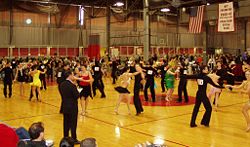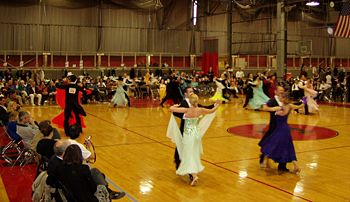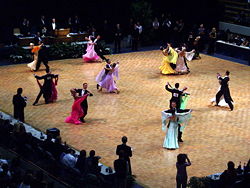Ballroom dance
Ballroom dance refers collectively to a set of partner dances, which originated in Germany and are now enjoyed both socially and competitively around the globe. Its performance and entertainment aspects are also widely enjoyed on stage, in film, and on television.
While historically ballroom dance may refer to any form of formal social dancing as recreation, with the eminence of dancesport in modern times the term has become much narrower in scope, usually referring specifically to the International Standard and International Latin style dances (see dance categories below). In the United States, two additional variations—"American Smooth" and "American Rhythm"—have also been popularized and are commonly recognized as styles of "ballroom dance."
Definitions and history
{{#invoke:Message box|ambox}}
The term "ballroom dancing" is derived from the word ball, which in turn originates from the Latin word ballare which means "to dance." In times past, ballroom dancing was "social dancing" for the privileged, leaving "folk dancing" for the lower classes. These boundaries have since become blurred, and it should be noted even in times long gone, many "ballroom" dances were really elevated folk dances.
The definition of ballroom dance also depends on the era. Balls have featured Minuet, Quadrille, Polonaise, Pas de Gras, Mazurka, and other popular dances of the day, which are considered to be historical dances. Today, the term applies to any one of the several dances in which two individuals, a "leader" and a "follower," dance with physical contact through their upper or lower bodies, or simply their arms depending on the particular variety of dance. Since most social dancing is unchoreographed, this contact is necessary for the leader to communicate the next dance move to the follower, and for the follower to respond to this insinuation. This stands in stark contrast with the style(s) of dance seen in clubs and other social gatherings where physical contact tends to be optional and the individuals in question can move freely without any such restraints imposed by firm physical contact or by the necessity to follow the rhythmic pattern present in the music. Some knowledge of known step patterns is essential for both the leader as well as the follower for ballroom dancing. As most ballroom style dances require some knowledge and practice, they have lessened in popularity among the public in the recent decades. Dance historians usually mark the appearance of the twist in the early 1960s as the end of social partner dancing.
Astaire and Rogers
In the early 20th century, the on-screen dance pairing of Fred Astaire and Ginger Rogers greatly influenced ballroom dancing in the USA. Although both actors had separate projects and careers, they are associated for their filmed dance sequences together, which included portrayals of early 20th century dancers Vernon and Irene Castle and have reached iconic status.[1] Much of Astaire and Rogers' work portrayed social dancing, although the performances were highly choreographed (often by Astaire or Hermes Pan), and meticulously staged and rehearsed.[2]
Competitive dancing
In spite of its historical image as a pastime for the privileged; formal competitions, sometimes referred to as DanceSport, often allow participation by less advanced dancers at various proficiency levels.
In the United States, amateur dance proficiency levels are defined by USA Dance (formerly United States Amateur Ballroom Dance Association, USABDA) as Bronze->Silver->Gold for syllabus dancers, and Novice->Prechampionship->Championship for open competitors.[3] These levels roughly correspond to the "E" to "S" levels in Europe and Australia. Among professionals, levels classify into Rising Star and Open Professional.
Eligibility and "leveling up" requirements will vary greatly between countries and sometimes within. For instance, in addition to USA Dance competitions, amateur dancers in the United States often participate in competitions sanctioned by NDCA or YCN (Youth Collegiate Network), each with its own distinct culture in addition to differing definitions of level and eligibility requirements.
The International Olympic Committee now recognizes competitive ballroom dance. It now appears doubtful that it will be included in the Olympic Games especially in light of efforts to reduce the number of offerings, but the application has not been permanently rejected.
Ballroom dancing competitions in the former USSR also included the Soviet Ballroom dances, or Soviet Programme. Australian New Vogue is danced both competitively and socially. In competition there are 15 recognised New Vogue dances, which are performed by the competitors in sequence. Internationally, the Blackpool Dance Festival, hosted annually at Blackpool, England, is considered the most prestigious event a dancesport competitor can attend.
Elements of competition

In competition ballroom dancers are judged by diverse criteria such as connection, frame, posture, speed, timing, proper body alignment, proper usage of weight/ankles/feet, and grooming. [4] Judging in a performance-oriented sport is inevitably subjective in nature, and controversy and complaints by competitors over judging placements are not uncommon. The scorekeepers—called scrutineers—will tally the total number recalls accumulated by each couple through each round until the finals, when the Skating system is used to place each couple by ordinals, typically 1-6, though the number of couples in the final can vary.
Medal examinations enable dancers' abilities to be recognized according to conventional standards. In medal exams, each dancer performs two or more dances in a certain genre (e.g., International Standard) in front of a judge. In North America, examination levels include Newcomer, Bronze, Silver, Gold and Championship. Each level (i.e. Newcomer, Bronze, Silver, Gold, Championship) may be further subdivided into either two or four separate sections.
Ballroom dancing isn't mainly enjoyed by only adults but it is taught to youngsters at an early age of 10-11 in the 5th grade in some US states. Not only are they taught, but they participate in city wide competitions. They are taught dances randomized from tango, rumba, swing(jitterbug), foxtrot and the merengue as a celebration to their senior year in elementary school. This competition is called "colors of the rainbow."
Dances
In one common usage "ballroom dance" refers to the ten dances of International Standard and International Latin, though the term is also often used interchangeably with the five International Standard dances [5] In the United States, the American Style (American Smooth and American Rhythm) also exists. The dance technique used for both International and American styles is identical, but International Standard allows only closed dance positions, whereas American Smooth allows closed, open and separated dance movements. In addition, different sets of dance patterns are usually taught for the two styles. International Latin and American Rhythm have different styling, and have different dance patterns in their respective syllabi.
Others dances sometimes placed under the umbrella "ballroom dance" include Nightclub Dances such as Lindy Hop, West Coast Swing, Nightclub Two Step, Hustle, Salsa, and Merengue. The categorization of dances as "ballroom dances" has always been fluid, with new dances or folk dances being added to/removed from to the ballroom repertoire from time to time, so no list of subcategories or dances is any more than a description of current practices. There are other dances historically accepted as ballroom dances, and are revived via the Vintage Dance movement.
In Europe, Latin Swing dances include Argentine Tango, Mambo, Lindy Hop, Swing Boogie (sometimes also known as Nostalgic Boogie), and Disco Fox. One example of this is the subcategory of Cajun dances that originated in New Orleans, with branches reaching both coasts of the United States.
Standard/Smooth dances are normally danced to Western music (often from the mid-twentieth century), and couples dance counter-clockwise around a rectangular floor following the line of dance. In competitions, competitors are costumed as would be appropriate for a white tie affair, with full gowns for the ladies and bow tie and tail coats for the men; though in American Smooth it is now conventional for the men to abandon the tailsuit in favor of shorter tuxedos, vests, and other creative outfits.
Latin/Rhythm dances are commonly danced to contemporary Latin American music, and with the exception of a few travelling dances (e.g. Samba and Paso Doble) couples do not follow the line of dance and perform their routines more or less in one spot. In competitions, the women are often dressed in short-skirted latin outfits while the men outfitted in tight-fitting shirts and pants; the goal being to bring emphasis to the dancers' leg action and body movements.
International Style
- International Standard
- Slow Waltz - Tango - Viennese Waltz - Slow Foxtrot - Quickstep
- International Latin
- Cha Cha - Samba - Rumba - Paso Doble - Jive
American Style
- American Smooth
- Waltz - Tango - Foxtrot - Viennese Waltz
- American Rhythm
- Cha Cha - Rumba - East Coast Swing - Bolero - Mambo
Historical/Vintage Dance
- Waltz - Polka - Schottische - Tango - One-Step - Foxtrot
Other dances occasionally categorized as ballroom
- Nightclub
- Nightclub Two-step - Hustle - Modern Jive / LeRoc / Ceroc - and the whole swing variety: West Coast Swing / East Coast Swing (always included in the "Rhythm-Swing" category) / Carolina Shag / Collegiate Shag
- Latin nightclub
- Salsa - Merengue - Cumbia - Bachata - Cha cha - Samba
- Brazilian Dances
- Forró - Pagode - Samba - Lambada
- Country/Western
- Polka - Cha-cha-cha - Two-step - Waltz...
- also referred to as "Country and Western" or C/W:
- C/W Polka - C/W Cha-cha - C/W Two-step - C/W Waltz...
- Cajun dances
- Cajun One Step or Cajun Jig - Cajun Two Step - Zydeco - Cajun Waltz - Cajun Jitterbug
- Other
- Argentine tango
- Peabody
- Cabaret.
In popular culture
mention of movies?
- Ice dancing, a branch of figure skating that derives from ballroom dance.
Notes
- ↑ History of Musical Film, by John Kenrick. Musicals101.com. Retrieved 2008-05-29.
- ↑ Review of "Swing Time" (1936). rogerebert.com (1998-02-15). Retrieved 2008-05-29.
- ↑ USABDA 2007-08 Rulebook. Retrieved 2007-02-20.
- ↑ What Judges Look For. Retrieved 2006-12-22.
- ↑ History of Modern Ballroom Dancing. Retrieved 2007-02-20..
ReferencesISBN links support NWE through referral fees
Buckman, Peter. Let's Dance: Social Ballroom & Folk Dancing. New York: Paddington Press, 1978 ISBN 0709200463 Gallafent, Edward. Astaire and Rogers. New York:Columbia University Press
External links
- Home Page. International DanceSport Federation.
- Home Page. USA Dance.
- Home Page. Canadian Amateur DanceSport Association.
- Learn to Ballroom Dance online
- The History of Ballroom Dancing
- Ballroom Dancing Is Hot to Fox Trot
- Ballroom Dancing Is Back in the Swing Again
Credits
New World Encyclopedia writers and editors rewrote and completed the Wikipedia article in accordance with New World Encyclopedia standards. This article abides by terms of the Creative Commons CC-by-sa 3.0 License (CC-by-sa), which may be used and disseminated with proper attribution. Credit is due under the terms of this license that can reference both the New World Encyclopedia contributors and the selfless volunteer contributors of the Wikimedia Foundation. To cite this article click here for a list of acceptable citing formats.The history of earlier contributions by wikipedians is accessible to researchers here:
The history of this article since it was imported to New World Encyclopedia:
Note: Some restrictions may apply to use of individual images which are separately licensed.



